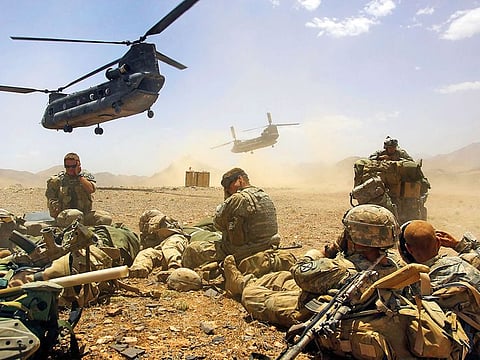Taliban close in on Kabul: Here is why the American project in Afghanistan failed
Top provincial governors have surrendered to the Taliban without even token resistance

“The Taliban have now pretty much taken over of Afghanistan,” as the American political satirist Bill Maher described the predicament of the international community this weekend, “we know it would happen, but not quite this fast.”
When US president Joe Biden declared on April 13, 2021 to withdraw American troops from Afghanistan by Sep. 11, 2021, anyone with some knowledge of the country knew that the Afghan government would not last long without American ground support.
Most of the US troops departed in July 2021. Since then, the Ashraf Ghani government’s control over Afghanistan has fallen like a pack of cards. That has led to severe criticism from both right and left of Biden’s decision to pull out from Afghanistan.
However, conservative commentators forget that Donald Trump had signed a peace agreement with the Taliban in February 2020 and had promised to withdraw troops by May 2021. Biden has not only followed that policy but has even extended the deadline by 130 days.
The criticism of the left and liberal circles is more surprising as they have been criticising the US military interventions in Afghanistan for the last 20 years, and now, blaming Biden for bringing an end to it. The defeat of the Afghanistan project of the US has been written on the wall since its beginning. If anything, President Biden has brought that long misery to an end.
After two decades, the US and its allies have not only been defeated in Afghanistan, but the Taliban has also become more powerful, resourceful, and even legitimate than what it was in 2001. Blaming Biden for withdrawing troops from Afghanistan or accusing Pakistan of its alleged support to the Taliban is unhelpful.
It will be rather prudent to introspect why a 20-year war, which cost the US nearly $2.3 trillion and sacrificed lives of more than 6000 of its troops and other personnel, has resulted in such a tragic end.
The US invasion of Afghanistan in 2001 was itself controversial. Anyone who understands Afghanistan’s history and ethno-religious character wouldn’t have put boots on the ground. Even if the US went in, it should have left Afghanistan in 2002 after dislodging the Taliban from power.
In 2002, the Taliban had been militarily defeated and was morally and diplomatically isolated. That would have been the right time to let Afghans run their country themselves and find a political system to accommodate the Taliban elements and concerns.
The US invaded Afghanistan based on its own security needs but decided to engage in an unrealistic state-building project in Afghanistan, as President Bush had proclaimed “a new era of human rights and human dignity.”
The lofty goal of creating a developed Afghanistan, where individual and group rights would be protected, and the rule of law would prevail, was a tall order to begin with. The hand-picked government by the US neither enjoyed legitimacy nor acceptance among the Afghans.
The post-Taliban period rulers of the ‘democratic’ Afghanistan were primarily ethnic group chieftains and warlords. In 2021, the Freedom House report continued to call the country ‘Not Free’, and its freedom score was 27 out of 100. Corruption and extortion became rampant in the last two decades, which helped the Taliban regain further popular support.
The development aid for Afghanistan increased from $1.3 billion in 2002 to $7.9 billion in 2018. Almost 80% of Afghanistan’s budget was being covered by foreign aid. Despite that, 34% of Afghans lived in poverty in 2007, increasing to 59% in 2017. Some growth in per capita income in the country has been primarily due to only some elites becoming extremely rich while the poor becoming poorer.
As per an evaluation in 2009 by the UK’s aid agency, for every $100 spent by donors in Afghanistan, only $20 reached the Afghan recipient. This was probably a generous estimation. Under the Taliban rule in 2000, poppy cultivation was taking place in 82,000 hectares, and in 2020, the area had increased to 224,000 hectares.
Though a lot has been written to justify the intervention to improve gender equality, West’s military assistance to Afghanistan was at least a thousand times more than what has been given for women empowerment.
In 2014, the former ISAF commanding General John Allen had told the US Congress that the corruption, not the Taliban, was the existential threat to the Afghan government. The Special Inspector General of Afghanistan Reconstruction, John Sopko, reiterated that assertion in March this year.
The world has witnessed now how corruption is playing its part in the abject surrender of provincial governors to the Taliban without even token resistance. The corruption, lack of professionalism, and fragmented ethnic loyalty have also led to the melting away of 300,000 strong ANDSF forces in front of 75,000 ragtag Taliban militants.
Afghanistan’s divided and corrupt governance and security system didn’t support the US cause. It would have been perhaps prudent for the US to select its allies carefully and not allow them to act as spoilers.
Instead of engaging in blame game now, the US and the international community would be better served if they sincerely investigate and introspect the reasons for their terrible failure on their protracted state-building project in Afghanistan.
Sign up for the Daily Briefing
Get the latest news and updates straight to your inbox








